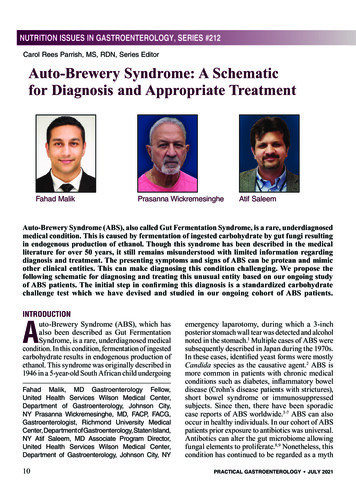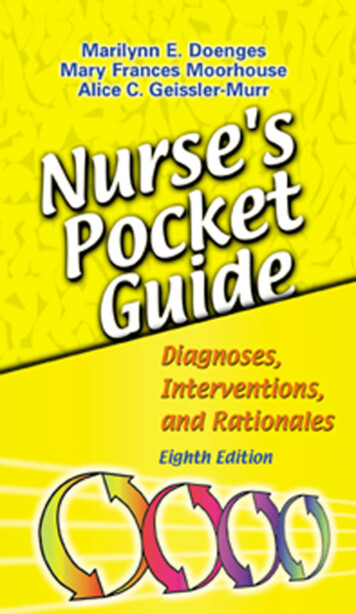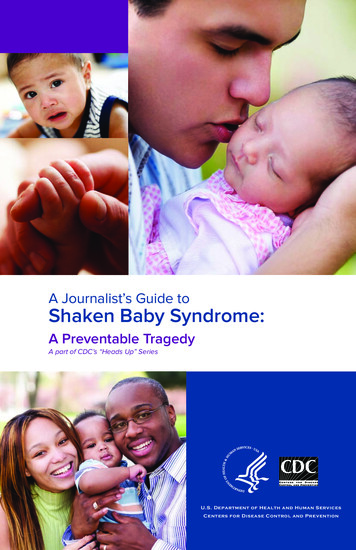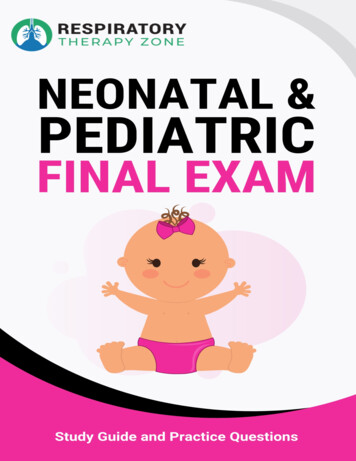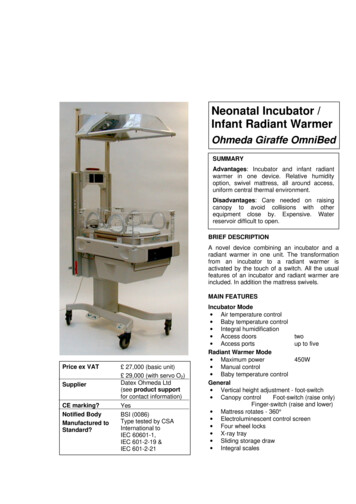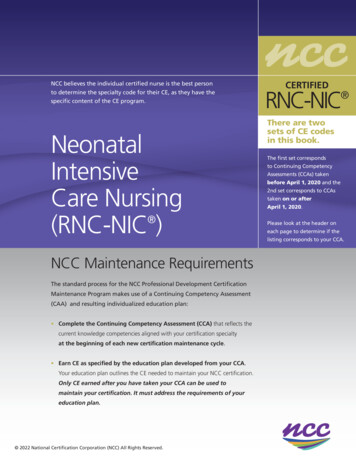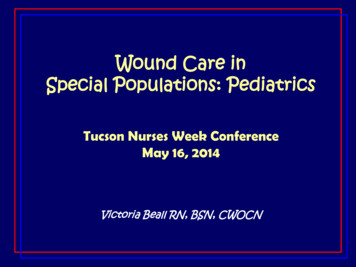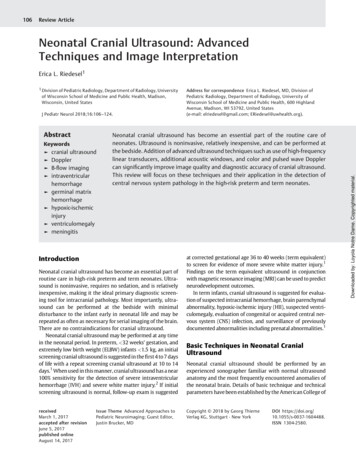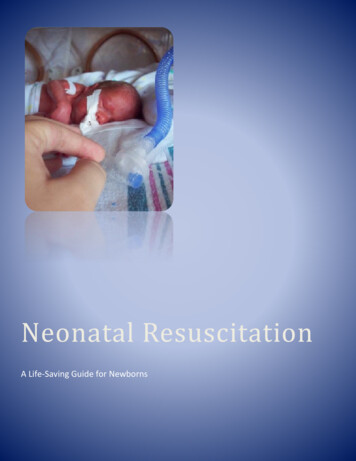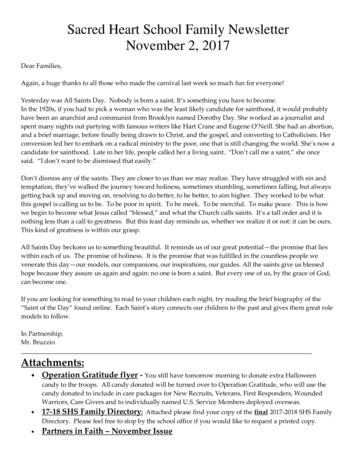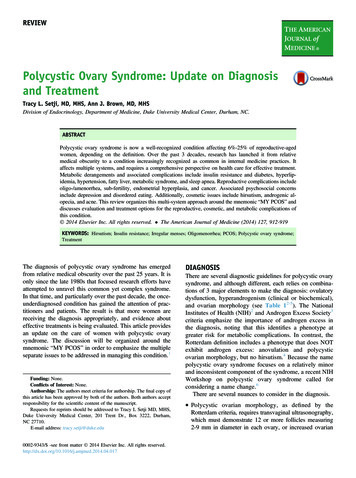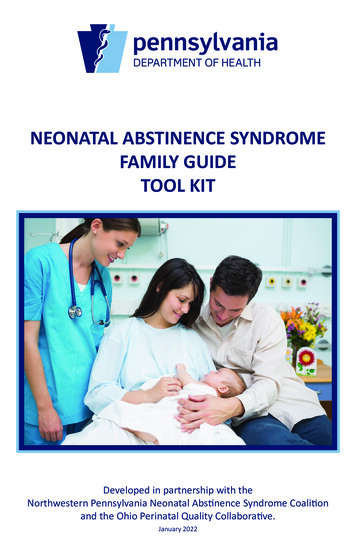
Transcription
pennsylvaniaDEPARTMENT OF HEALTHNEONATAL ABSTINENCE SYNDROMEFAMILY GUIDETOOL KITDeveloped in partnership with theNorthwestern Pennsylvania Neonatal Abstinence Syndrome Coalitionand the Ohio Perinatal Quality Collaborative.January 2022
pennsylvaniaDEPARTMENT OF HEALTHNEONATAL ABSTINENCE SYNDROMEWelcomeCONGRATULATIONS ON THE BIRTH OF YOUR NEW BABY!This is a happy time for you! However, it is important to know that all parents facechallenges in their baby’s first year. Your family and friends who support you canhelp you be successful.Some babies need extra loving, including those born with Neonatal AbstinenceSyndrome (NAS).It doesn’t matter why your baby is going through withdrawal; you need to help yourbaby now.This guide was written to: Help you learn about NAS; Encourage you to share your substances or medication history with your doctorand nurse; Answer your questions about NAS so you can take good care of your baby; and Help you help your baby be healthy and safe.The information in this guide should not take the place of medical care and advicefrom your healthcare provider. Please do not stop taking any medications or drugs suddenly. Always check with your doctor before you start or stop taking any drug ormedication. It is very important to tell your nurse and your baby’s doctor about allmedicines used during your pregnancy; this will help the doctor treat your babyproperly. This is also the best way for you to help your baby.If you have a question that is not answered in this guide, ask your doctor or nurse.They are there to answer your questions. Many other parents probably have hadthe same question as you do.Disclaimer: The images of people in this booklet are visual representations only.2
pennsylvaniaDEPARTMENT OF HEALTHNEONATAL ABSTINENCE SYNDROMETable of ContentsWELCOME . . . . . . . . . . . . . . . . . . . . . . . . . . . . . . . . . . . . . . . . . . . . . . . . . . . . . . . . . . . 2NEONATAL ABSTINENCE SYNDROME (NAS) . . . . . . . . . . . . . . . . . . . . . . . . . . . . . . . . 4 What is Neonatal Abstinence Syndrome? What are the signs and symptoms of NAS? When will my baby show signs of NAS? What will happen if my baby is in withdrawal?TREATMENT . . . . . . . . . . . . . . . . . . . . . . . . . . . . . . . . . . . . . . . . . . . . . . . . . . . . . . . . . 6 Does my baby need medicine to get better? How long will my baby need treatment? How can I help my baby? Can I breastfeed my baby?WHAT TO EXPECT . . . . . . . . . . . . . . . . . . . . . . . . . . . . . . . . . . . . . . . . . . . . . . . . . . . . . 8 Plan of Safe Care Home visitor pregnancy programs Bringing baby home Home visitor programsWAYS TO SUPPORT YOU AND YOUR BABY . . . . . . . . . . . . . . . . . . . . . . . . . . . . . . . . 14 Ways to support you Keeping your baby calm Learn your baby’s “I’m upset cues” Special ways to help your baby Safe sleep Happiest Baby on the Block Car seat safetySUBSTANCES BABY MAYBE EXPOSED TO DURING PREGNANCY . . . . . . . . . . . . . . . 20 Alcohol Tobacco/Vaping MethamphetamineRESOURCES FOR YOU AND YOUR FAMILY . . . . . . . . . . . . . . . . . . . . . . . . . . . . . . . . 23 Resources for more informationNOTES FOR YOU AND YOUR BABY . . . . . . . . . . . . . . . . . . . . . . . . . . . . . . . . . . . . . . 30 Notes about baby and immunizations Emergency preparednessNORTHWEST PENNSYLVANIA NAS COALITION MEMBERS . . . . . . . . . . . . . . . . . . . 343
pennsylvaniaDEPARTMENT OF HEALTHNEONATAL ABSTINENCE SYNDROMERecognizing Neonatal Abstinence SyndromeBACKGROUNDThere are times we need to take medications to take care of ourselves. Someof these prescribed medications that can affect babies include blood pressuremedications and antidepressants.Make sure to talk to your doctor about all your medications and follow theirdirections. These medications may affect your baby and can increase the symptomsof Neonatal Abstinence Syndrome (NAS).Some babies will have NAS even though their mothers only took small doses ofmedicines for a short time during pregnancy. Other babies may show signs becausetheir mothers took or used large amounts of drugs for a long time while pregnant.WHAT IS NEONATAL ABSTINENCE SYNDROME?Neonatal Abstinence Syndrome (NAS) is a group of withdrawal symptoms innewborns that show up after being exposed to medications or substances, mostoften opioids, benzodiazepines and/or barbiturates during pregnancy.NAS happens when the baby is born and suddenly cut off from the medicines ordrugs in a mother’s body, similar to medicine or drug withdrawal in adults.This can include medications prescribed for you by your doctor, which is why it is soimportant to recognize signs and symptoms of NAS and know the proper ways tohelp your baby.WHAT ARE THE SIGNS AND SYMPTOMS? High pitched cries or excessive crying; Crankiness; Stiff arms, legs and back; Trouble sleeping; Shaking and jitters; Fast breathing and/or stuffy nose; Sneezing and yawning a lot; Increased temperature; Poor weight gain after a few days of life; Vomiting due to overeating or crankiness; Not eating well, having problems sucking or excessive sucking; Irritation on face, back or head, arms and legs due to restlessness; Irritation on the diaper area due to loose watery stools; and Seizures, also called convulsions. Seizures can be hard to spot and can lastseconds to minutes. Your baby may suddenly start jerking his or her arms andlegs and may go completely stiff. You may see eye rolling, staring, lip smacking,sucking, or a change in skin color. Seizures are a late sign of NAS.4
pennsylvaniaDEPARTMENT OF HEALTHNEONATAL ABSTINENCE SYNDROMERecognizing Neonatal Abstinence SyndromeWHEN WILL MY BABY SHOW SIGNS OF NAS?Your baby may start to show signs of NAS between one and five days after birth. Insome instances, NAS symptoms and effects can occur in babies up to one year afterbirth or beyond.The time it takes for signs to show can depend on how much and what kind ofmedicine or drug the baby’s mother took and for how long. It also can depend onwhether or not the baby’s mother used other kinds of substances such as alcohol,tobacco, or additional medicines.WHAT WILL HAPPEN IF MY BABY IS IN WITHDRAWAL?Beginning soon after your baby’sbirth, your baby will be monitoredfor withdrawal symptoms anda Plan of Safe Care may bedeveloped.The nurses will check for certainsigns in your baby and give thema score depending on which NASsigns are present.Each sign or symptom is importantin evaluating the health and needs of your baby to determine the score value.Your baby: Should be assessed for signs of withdrawal every three to four hours until theyare ready to go home. Should have all signs scored within the preceding three to four-hour interval,not just signs that occur during the assessment. Should not be awakened unless they have been asleep for more than threehours. Should be fed before they are scored and calmed prior to assessing muscle toneand respiratory rate.How your baby is scored will be explained to you when your baby is born. You canhelp score your baby by telling your nurse or doctor about signs you see, such as:sneezing, frequent yawning, vomiting, how often your baby stooled, how long yourbaby was awake, and how long your baby slept.Ask your delivering facility to share their scoring sheet with you, what the scoremeans, and what treatment your baby will need. The scoring helps doctors decidewhich types of treatment your baby needs to get better.5
TREATMENTCaring for My BabypennsylvaniaDEPARTMENT OF HEALTHBACKGROUNDNeonatal Abstinence Syndrome (NAS) can be present in babies for one week or lastup to many weeks; it is hard to know how long it will last. The doctors and nurseswill monitor your baby, and you can help also.There are different types of scoring documents. Ask your birthing facility to sharethe type they use. During your hospital stay, NAS signs and symptoms shoulddecrease. Your baby will be discharged when there is little risk for problems.DOES MY BABY NEED MEDICINE TO GET BETTER?If your baby’s NAS score is high, they are likelyexperiencing NAS withdrawal and the nursewill ask the doctor to evaluate them.Your baby may need medicine to help. Givingyour baby medicine will help make themcalm and be more comfortable. This will alsoreduce the risk of your baby having a seizure.The most common medicine given to babieswith NAS are morphine and methadone.Sometimes other medicines may be added tohelp your baby during this time.As your baby starts to feel better, the dose of medicine will be slowly lowered andeventually stopped. It is important to ask your doctor or nurse to explain yourbaby’s medication in more detail if you have any questions.HOW LONG WILL MY BABY NEED TREATMENT?Babies who do not need medication to control NAS symptoms may need to stay inthe hospital for up to a week.Many babies who need medication for NAS symptoms stay in the hospital three tofour weeks. In rare cases, some may stay longer, it all depends on how your babyresponds to treatment.The length of withdrawal is different for each baby and will depend on the amountof medicine or substances your baby was exposed to during pregnancy: How long it takes for the substanceto leave your baby’s body; and How long your baby needsmedicines to help ease thediscomfort of withdrawal.6
TREATMENTCaring for My BabypennsylvaniaDEPARTMENT OF HEALTHHOW CAN I HELP MY BABY?If your baby is showing signs of withdrawal, sometimes love and care may be thebest medicine. Practice caring for your baby while you are in the hospital, so you aremore comfortable when your baby is at home.You are an important part of your baby’s recovery. Your baby knows your voice andwants to be comforted by you.There are a number of different ways you can help your baby through this time.These include: Stay with your baby at the hospital as much as you can; Continually holding and swaddling them; Making skin-to-skin contact; Keeping things quiet and calm around them; Breastfeeding; Using services within your county; and Talking with your baby’s doctor daily to knowhow your baby is doing.CAN I BREASTFEED MY BABY?Breastfeeding may help your baby, so if youwish to breastfeed, talk to your doctor or nurseabout breastfeeding and the medications youare taking, including any newly prescribedmedications.Your doctor or nurse will be able to tell you if itis safe for your baby and ask about breastfeeding(lactation) support.It is generally safe for mothers to breastfeed ifthey are in a stable drug and alcohol treatment program, even if they are takingmedicine given by a doctor or nurse and the medicine is for substance withdrawal.Mothers who are not in a drug and alcohol treatment program or who are using alcoholor substances should talk to their doctor or nurse about breastfeeding their baby.If you choose to breastfeed, you need to know that if you stop breastfeedingabruptly (suddenly, without weaning gradually), your baby may experiencewithdrawal or increased withdrawal symptoms if you have been on medicationwhile nursing.If you are not in a drug and alcohol treatment program for substance use disorder/opioid use disorder, now is a good time to talk to your doctor about entering one.Please see DDAP’s find treatment webpage or call 1-800-662-HELP vider.aspx7
pennsylvaniaDEPARTMENT OF HEALTHWHAT TO EXPECTPlan of Safe CareBACKGROUNDA Plan of Safe Care can be developed anytime during your pregnancy. Beginningsoon after your baby’s birth, your baby will be monitored for withdrawal symptoms.Your doctor and nurses will help you prepare for discharge and your baby’s Plan ofSafe Care may be developed which can link you to services for your baby.WHAT IS A PLAN OF SAFE CARE?Plans of Safe Care go beyond the immediate safety factors of the baby. It addressesthe baby’s health, development and treatment needs, as well as the needs of thebaby’s family or caregiver.WHAT IS THE GOAL OF A PLAN OF SAFE CARE?The goal of a Plan of Safe Care is to keep your baby safe and help you when youneed it. To see Plans of Safe Care access: ans-of-Safe-Care.aspxWHO HELPS TO MAKE A PLAN OF SAFE CARE?Healthcare providers will notify the Department of Human Services (via Childline)when a baby is affected by prenatal substance use, withdrawal symptoms ordiagnosed with NAS, or Fetal Alcohol Spectrum Disorder (FASD). A Plan of Safe Carecan help connect you to a multidisciplinary team (MDT) that will offer support toyour new baby. This team can include agencies from drug and alcohol treatmentprograms, social support services and healthcare systems.A Plan of Safe Care may incorporate services and supports for diverse, longer-termneeds, including physical and mental health, substance use disorder/opioid usedisorder treatment, parenting education, infant developmental screening and otherfamily needs.Your physician may recommend your baby have follow up appointments with EarlyIntervention and/or a Developmental Clinic to make sure they are meeting theproper milestones as they grow.8
WHAT TO EXPECTPlan of Safe CarepennsylvaniaDEPARTMENT OF HEALTHPlan of Safe Care participants may be from the following areas: Health: Parents/Caregiver’s healthcare: Pediatrician Substance use disorder/Opioiduse disorder treatment Primary Care Providers Medication-assisted treatment(MAT) Health specialists Health insurance Mental Health services Development: Parenting/Family support: Developmental Clinics Education on appropriate infantcare Early Intervention Parents as Teachers Coordinated care managementfor parents and family with thebaby Education with county agencies Mother’s healthcare: Infant bonding support Primary Care Physician Nurturing parenting support OB/GYN Home care visits Prenatal education Interventions for family violence Pain management Continuing education for parents Breastfeeding support Employment support Health insurance Safety nets and recovery support Safety: Health of the infant Immediate safety of the baby Safety of the environment Child welfare supportive andeducational services9
WHAT TO EXPECTHome Visitor Pregnancy ProgramspennsylvaniaDEPARTMENT OF HEALTHBACKGROUNDWhen you are pregnant, many mothers have questions regarding pregnancy and canuse additional support. When you prepare for your baby’s arrival, you will feel moreconfident and comfortable when your baby is at home. You are an important part ofyour baby’s recovery.There are several individuals and resources that you can use to make sure you areprepared to have your baby. During your pregnancy talk to your doctor, nurse, socialworker, or resource coordinator for resources close to home. They can also help youmake a Plan of Safe Care for your baby.WHAT IS A HOME VISITORPROGRAM?Home visiting programs help parents andcaregivers with the support necessary toimprove the health, safety, literacy, andeconomic security of the family.In home visits, nurses and other trainedprofessionals visit pregnant people, families,and children in the beginning of pregnancy to promote positive birth outcomes andprovide parent education and support, ultimately promoting the child health,well-being, learning and development.Home visitation programs may be available to serve pregnant people, infants,and toddlers. Your county may have a program for children and families who aretouched or affected by substance use disorder/opioid use disorder.Doula programs and Nurse Family Partnerships (NFP) are a few of the home visitorpregnancy programs that may be in your area.WHAT IS DOULA PROGRAM?A doula is a professional who is trained in providing continuous emotional, physical,and educational support to people during pregnancy, labor and delivery, and theearly post-partum period with home visits. A doula also encourages the mother tobe informed about different birth choices.Doulas are not medical professionals and do not perform medical tasks or deliverbabies. Community doula programs may be available to any pregnant person whoresides in your area. Contact your local Human Services agency to see if there is aprogram near you.WHAT IS NURSE FAMILY PARTNERSHIP?A Nurse Family Partnership pairs first-time low-income pregnant people with nursesto improve pregnancy/birth outcomes, child health and development, and familyeconomic self-sufficiency.10
WHAT TO EXPECTBringing Baby HomepennsylvaniaDEPARTMENT OF HEALTHBACKGROUNDWhen your baby comes home, the journey continues. If you practice caring for yourbaby while you are in the hospital, you will be more comfortable when your baby isat home. You are an important part of your baby’s recovery.It’s important to remember, babies cry a lot and babies with Neonatal AbstinenceSyndrome tend to cry more often and more easily. You may not always be able toget your baby to stop crying and that is OK- crying never hurt a baby.There are several resources that you can use to make sure you are prepared to bringyour baby home. During your hospital stay, talk with your baby’s social worker orresource coordinator for resources close to home.They can also help you make a Plan of Safe Care for your baby. Nurses andphysicians will help you prepare for discharge, and your baby’s Plan of Safe Care canlink you to services.BRINGING BABY HOMEBabies can continue to have mild symptoms of withdrawal for up to six monthsafter leaving the hospital. Once at home, your baby may continue to experience thefollowing: Problems feeding; Slow weight gain; Fussiness or crankiness; Sneezing or stuffy nose; and Sleeping for brief periods of time.Your baby’s doctor and nurse will teach you ways to take care of your baby. Theywill show you how you can help your baby if they are having any of the signs andsymptoms listed above.Follow the doctor and nurse’s directions for taking care of yourself and your baby.Asking questions helps you help your baby. Babies with Neonatal AbstinenceSyndrome may have additional needs, home visitor programs can help you learnhow to help your baby.11
WHAT TO EXPECTHome Visitor ProgramspennsylvaniaDEPARTMENT OF HEALTHBACKGROUNDBabies with Neonatal Abstinence Syndrome may not be meeting developmentalmilestones. Your physician may recommend your baby have follow up appointmentswith Early Intervention and/or a Developmental Clinic to make sure he or she ismeeting the proper milestones as they grow.There are several home visitor programs that may be in your area: Early Intervention; Early Head Start (EHS); Family Check Up (FCU); Healthy Families America(HFA); Parents-As-Teachers (PAT);and Self-Care Augmented.WHAT IS EARLY INTERVENTION?Early Intervention provides services and support for young children who havedelays or developmental disabilities and is designed to help families and caregiversfoster the growth and development of the child. While all children grow and changeat their own rate, some children can experience delays in their development.Sometimes this can be cause for concern.Early Intervention: Is individualized to enhance the child’s growing and learning; Can also assist families link to a variety of community services and supports; Provide ideas for how the family can help their child at home and in thecommunity; Can include: Information on how children develop; Parent and caregiver education; Support services; Developmental instruction and therapies that assist in child development;and Assistance for your child’s early childhood educator with strategies topromote your child’s development.WHO IS ELIGIBLE FOR EARLY INTERVENTION?Infants, toddlers, and preschool children who have special needs due to a minimumof 25% in developmental delays or disabilities and meet other requirements canreceive Early Intervention support and services at no cost to families.12
WHAT TO EXPECTHome Visitor ProgramspennsylvaniaDEPARTMENT OF HEALTHWHERE DO CHILDREN AND FAMILIES RECEIVE SUPPORT & SERVICES?Services and support are embedded in the learning opportunities that exist in thechild’s typical routine within the home, community, and other early childhoodeducation programs. Early childhood education programs can include childcarecenters, nursery schools, pre-kindergarten programs or Head Start.WHO SHOULD FAMILIES CONTACT TO SEE IF THEIR CHILD IS ELIGIBLEFOR EARLY INTERVENTION?A first step for any family with a concern about their child’s development is to callCONNECT services. The CONNECT helpline staff will refer a family to your local EarlyIntervention agency, who will determine if the child is eligible for services. TheCONNECT toll free number is 1-800-692-7288 or you can call your county’s EarlyIntervention program.WHAT IS EARLY HEAD START?Early Head Start enhances the ability of low-income families to meet thedevelopmental and early learning need of their children at home. Children who areeligible can receive services such as: Year-round comprehensive child and family development services; Weekly, home-based visits; Bimonthly Family Interaction Time events; Parent information, health and safety education; Referrals to other local resources; and Services, free of charge, to low-income pregnantwomen and children from birth to age 3.WHAT IS FAMILY CHECK UP (FCU)?Family Check Up support strategies to better engage parent and parent-centeredintervention for reducing problem behaviors in children from toddler throughadolescence.WHAT IS HEALTHY FAMILIES AMERICA (HFA)?Healthy Families America strengthen families by promoting positive parenting,enhancing child health and development, and preventing child abuse and neglect.WHAT IS PARENTS–AS–TEACHERS (PAT)?Parents- As- Teachers build the capacity of parents to care for their children whilepromoting school readiness and healthy child development.WHAT IS SELF CARE AUGMENTED?Self Care Augmented aims to prevent and address factors associated with childabuse and neglect through motivational interviewing and additional training toidentify and respond to imminent child maltreatment and risk factors.13
pennsylvaniaDEPARTMENT OF HEALTHWAYS TO SUPPORT YOU AND YOUR BABYKeeping You and Your Baby HappyBACKGROUNDWhen your baby leaves the hospital, they will be exposed to a new world with manythings they are not familiar with. It’s important to gently introduce them to differentsituations and items one at a time so they do not get overstimulated or upset. Thistime can also be difficult for you too, which is why it is important to take time foryourself so you can give your baby the proper care they need.WAYS TO SUPPORT YOUTaking care of yourself will help you to care for your baby.Eating, sleeping, managing your stress, taking breaks, andasking others for help are ways to care for yourself. Call someone to come and help you—everyoneneeds help sometimes. Do not hold or touch your baby when you are angry. When all else fails, put the baby in a safe place (crib)and WALK AWAY! Calm down, regroup, and check on the baby in fiveminutes.If you are in a drug alcohol treatment program, stay as long as your doctor tells youto. To find a drug and alcohol treatment program near you, please call1-800-662-HELP (4357).If you smoke, do not smoke in the home or around the baby—smoke outside.Nicotine may make your baby’s symptoms more severe. Find a Quit Smokingprogram at itline.aspx orcall the PA Quitline: 1-800-QUIT-NOW or 1-800-784-8669.KEEPING YOUR BABY CALMThere are several things you can do to support and care for your baby after bringingthem home. Gently introduce new things to your baby one at a time: Maintain a routine; Do not overdress your baby; Report a body temperature higher than 100 degreesFahrenheit to your doctor; Limit visitors so your baby does not get overstimulated; Keep your baby’s room quiet with the lights down low; Add visual, sight, sound and touch stimuli when your baby is calm; and Know that your baby’s ability to handle new stimuli may vary from minute-tominute and day-to-day.As your baby becomes calmer for longer periods of time, start to check if they like tohave the blanket wrapped or swaddled more loosely or taken off for short periodsof time.14
pennsylvaniaDEPARTMENT OF HEALTHWAYS TO SUPPORT YOU AND YOUR BABYKeeping You and Your Baby HappyLEARN YOUR BABY’S “I’M UPSET’ CUESYour baby will tell you “I’m upset” by: Yawning; Sneezing; Having tremors or shaking; Putting his or her hand up like a stop sign; Showing color changes (pale) in skin; Frowning; and Looking away or closing his or her eyes.If you see the above cues, stop what you aredoing. Your baby is telling you “I’m upset.”SPECIAL WAYS TO HELP YOUR BABY IF THEY ARE UPSET Stop what you are doing; Check for signs of illness and call the doctor if you are concerned; Hold your baby: Allow them to calm down and rest; Carefully swaddle and rock gently orsway; and Make skin to skin contact (their barechest to your bare chest); Remember to let your baby sleep as long asneeded and wake your baby gently; Let your baby calm down completely beforetrying anything new; Change the diaper or clothing if wet fromsweat; Take the baby for a walk in the stroller or acar ride; Settle into a quiet, low-light room to feed your baby; Do not walk or sway your baby while feeding; Feed or offer a pacifier (over feeding can cause fussiness); and Play soothing music softly or introduce another soft sound like white noise orquiet shushing, singing or talking.15
pennsylvaniaDEPARTMENT OF HEALTHWAYS TO SUPPORT YOU AND YOUR BABYSafe SleepBACKGROUNDMore than 3,500 babies in the United States die suddenly and unexpectedlyevery year while sleeping, often due to Sudden Infant Death Syndrome (SIDS) oraccidental deaths from suffocation or strangulation.While it’s important for you to know the safest ways to support your baby, it’salso important to make sure this is shared with anyone who cares for your baby,including grandparents, family, friends, babysitters, and child care center staff.WHAT CAN YOU DO? Always place your baby to sleep on their back every time up until they are oneyear old. The crib or bassinet should be bare and firm with a tight-fitted sheet. Do notuse soft or loose bedding, including crib bumpers, blankets, pillows, and softtoys. Schedule and go to all well-child visits. Your baby should receive allrecommended vaccinations or immunizations. Avoid exposing your baby to smoke, alcohol and substances. Supervised, awake tummy time is recommended daily to help your baby growand develop. Infants should never sleep in seating devices like car seats, swings, andbouncers. Babies should always be transferred to a crib or portable crib for safesleep.HOW CAN I REDUCE THE RISKOF SIDS? Breastfeed as much and for aslong as you can; Don’t let your baby get too hot; Give a pacifier at nap time andbedtime; Don’t use home monitors orcommercial devices, includingwedges or positioners, marketedto reduce the risk of SIDS; and Share a bedroom with your baby for at least the first six months and preferablyuntil the baby turns one.It is important that you do not share the same sleeping surface—babies should be ina crib or bassinet.16
pennsylvaniaDEPARTMENT OF HEALTHWAYS TO SUPPORT YOU AND YOUR BABYSafe SleepCAN I SWADDLE MY BABY WHEN THEY SLEEP?Yes, it is fine to swaddle your baby, but make sure the baby is always on their back.The swaddle shouldn’t be too tight or make it hard for the baby to breathe or movethe hips. When your baby looks like they are trying to roll over, you should stopswaddling. Your nurse can help you learn how to swaddle your baby if you want topractice but don’t know how. More Information on swaddling and a diagram can befound below.HAPPIEST BABY ON THE BLOCKThe Basics of the 5 S’s Method for Soothing BabiesThe 5 S’s Method was invented to remember the different variations of the calming,womb-like sensations babies are used to. Happiest Baby on the Block, techniquesdeveloped by Dr. Harvey Karp.1. The 1st S: SwaddleSwaddling recreates the snug packaginginside the womb and is the cornerstoneof calming. It decreases startling andincreases sleep. Babies shouldn’t beswaddled all day, just during fussing andsleep.2. The 2nd S: Side or Stomach PositionThe back is the only safe position forsleeping, but it’s the worst position forcalming fussiness. This S can be activatedby holding a baby on their side, on stomachor over your shoulder. Do this while awakeonly.3. The 3rd S: ShushContrary to myth, babies don’t need totalsilence to sleep. In the womb, the soundof the blood flow is a shush louder than avacuum cleaner!4. The 4th S: SwingWhile slow rocking is fine for keeping quietbabies calm, you need to use fast, tinymotions to soothe a crying infantmid-squawk.5. The 5th S: SuckMany fussy babies relax into a deeptranquility when they suck. Using a pacifiercan make it easier to calm your baby.17
pennsylvaniaDEPARTMENT OF HEALTHWAYS TO SUPPORT YOU AND YOUR BABYCar Seat SafetyBACKGROUNDMotor vehicle crashes are a leading cause of death among children. It is importantto make sure children aged 12 and under are buckled in age- and size-appropriatecar seats, booster seats, or seat belts, and are always in the back seat.Pennsylvania law states that a car seat must be used correctly as designated by thecar seat manufacturer.BRINGING BABY HOMEPremature and low-birth weight infants have special needs. The hospital mayrequire a Car Seat Tolerance Screening for your baby to make sure they can tolerateriding in the semi-reclined car seat. You should pick a car seat tha
Jan 26, 2022 · CONGRATULATIONS ON THE BIRTH OF YOUR NEW BABY! This is a happy time for you! However, . Special ways to help your baby Safe sleep Happiest Baby on the Block Car seat safety SUBSTANCES BABY MAYBE EX
